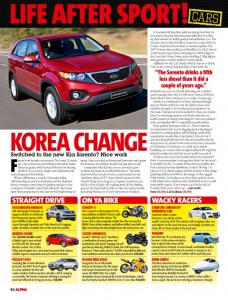 Korea Change
Korea Change
A rather sombre reflection on the Sorento. Maybe I’d reversed over the cat that morning, or something. Or more likely I’d been told to “stop writing idiotic car reviews”. For Alpha magazine.
________
Funny how brands change. Not even 20 years ago, the American car industry was what made America great, with General Motors its shining symbol of economic might and industrial and technological invincibility.
What a difference a couple of decades make. GM is having an enforced rethink, and the industry there is trying to introduce its lardy populace to the concepts of “smaller” and “fuel-efficient”. But it’s all a bit late. The Asians have been preparing for the current belt-tightening for years. Mocked for years as flimsy and low-rent, who knew that the Korean car industry would one day save us all?
Companies like Hyundai and Kia often work cheek-by-jowl in Korea: proud, hard-working, but not too proud to give us what we want at an affordable price. The new, improved Kia Sorento is the current leader in the “medium urban SUV” class, which means it’s the closest thing you can get to a regular runabout, yet still do a bit of light off-roading with all the camping gear in the back and be able to take the entire family, including Nanna, to Crusty Demons on Sunday.
If you want all that, Kia really are doing their best for you, and in the past few years especially they’ve rolled up their sleeved on build-quality and aesthetics too. The Sorento even looks a bit like a Lexus, but costs a hell of a lot less. But this is more than just a cosmetic update. The 2007 Sorento was a solid, no frills affair; for 2009, there’s a new monocoque frame, meaning it’s a little longer at the front, but 55mm lower, and a startling 215kg lighter, with genuine comfort inside for seven adults.
The fuel consumption is equally impressive. Alpha drove the 2.2L diesel, which claims to drink 7.4 litres of derv every hundred kays. Even with the windows up, aircon off and sweating, we couldn’t quite match it, but it’s still more than a fifth less than what it was costing you a couple of years ago.
Inside is a combination of basic and surprisingly speccy. Plastics still rule, but the layout is at least clear, and controls intuitive enough to let you keep most of your attention firmly on the road. But just as you’ve settled for that, you realise they’ve added a reversing camera as standard; and dual-zone aircon; leather seats; proximity warnings for nervous parkers; and a six-speaker MP3-compatible sound system.
Ride quality has improved too. There’s almost no impression that you’re towing such a big wagon behind your drivers’ seat. Independent, self-levelling, multi-link suspension sounds like a mechanics’ love-in, but for the man at the wheel it means a beautifully smooth ride and excellent shock absorption, no matter how much everyone’s overeaten at Christmas. It’s a lot sharper, too, with more stable handling on corners and enough proper feedback through the wheel to make you feel that you’re really in control.
At this point you may be wondering when the heck we’ll start driving it up mountains or along river beds, but we won’t. It just wouldn’t be fair. To make all the above possible, Kia had to beat a tactical retreat elsewhere. Gone is the big 3.3L petrol or 2.5L diesel engine and the Sorento’s low-range grinding ability, and with it the image of the rugged bush-basher. In its place is a smoother, quieter, more solid urban drive, with as much flexibility as you could reasonably expect. If you want to go the other side of Bourke, that’s your other car.
________
See as a higher-res PDF: